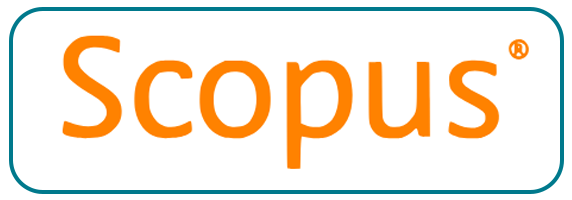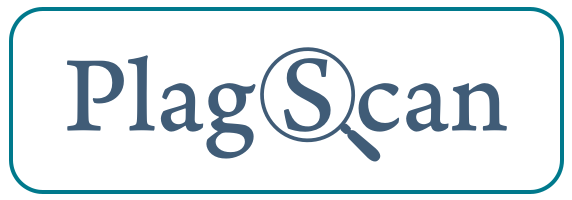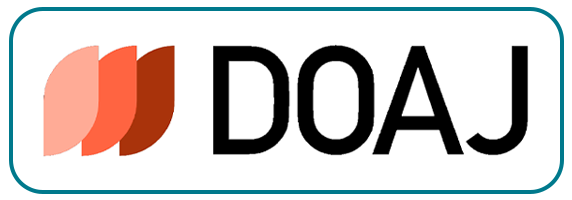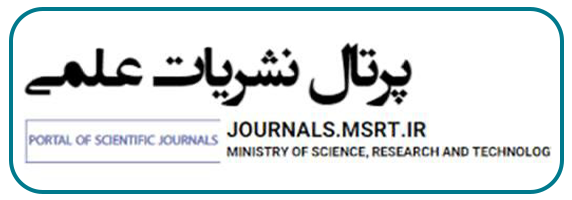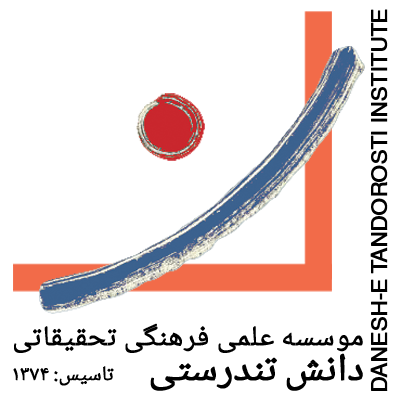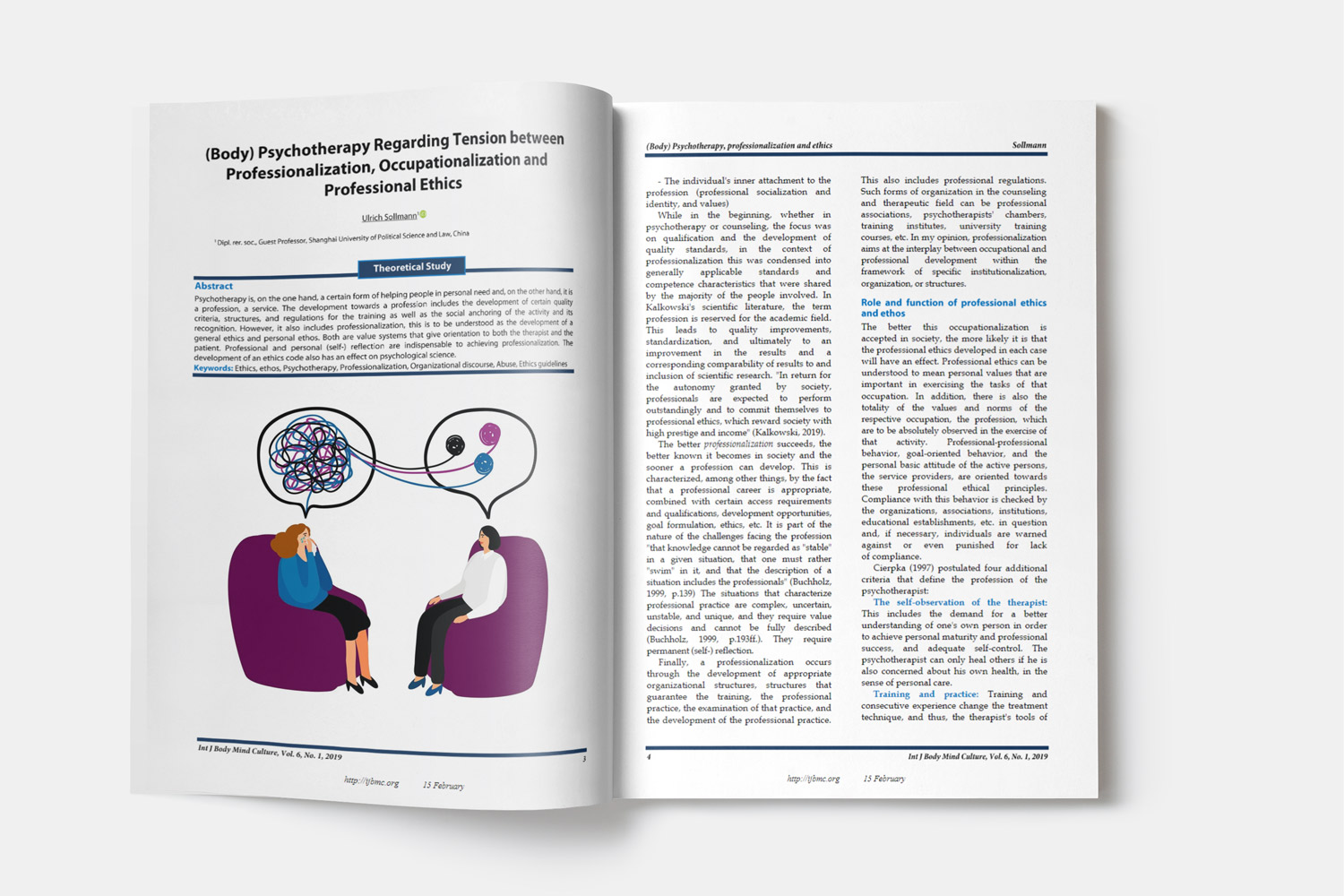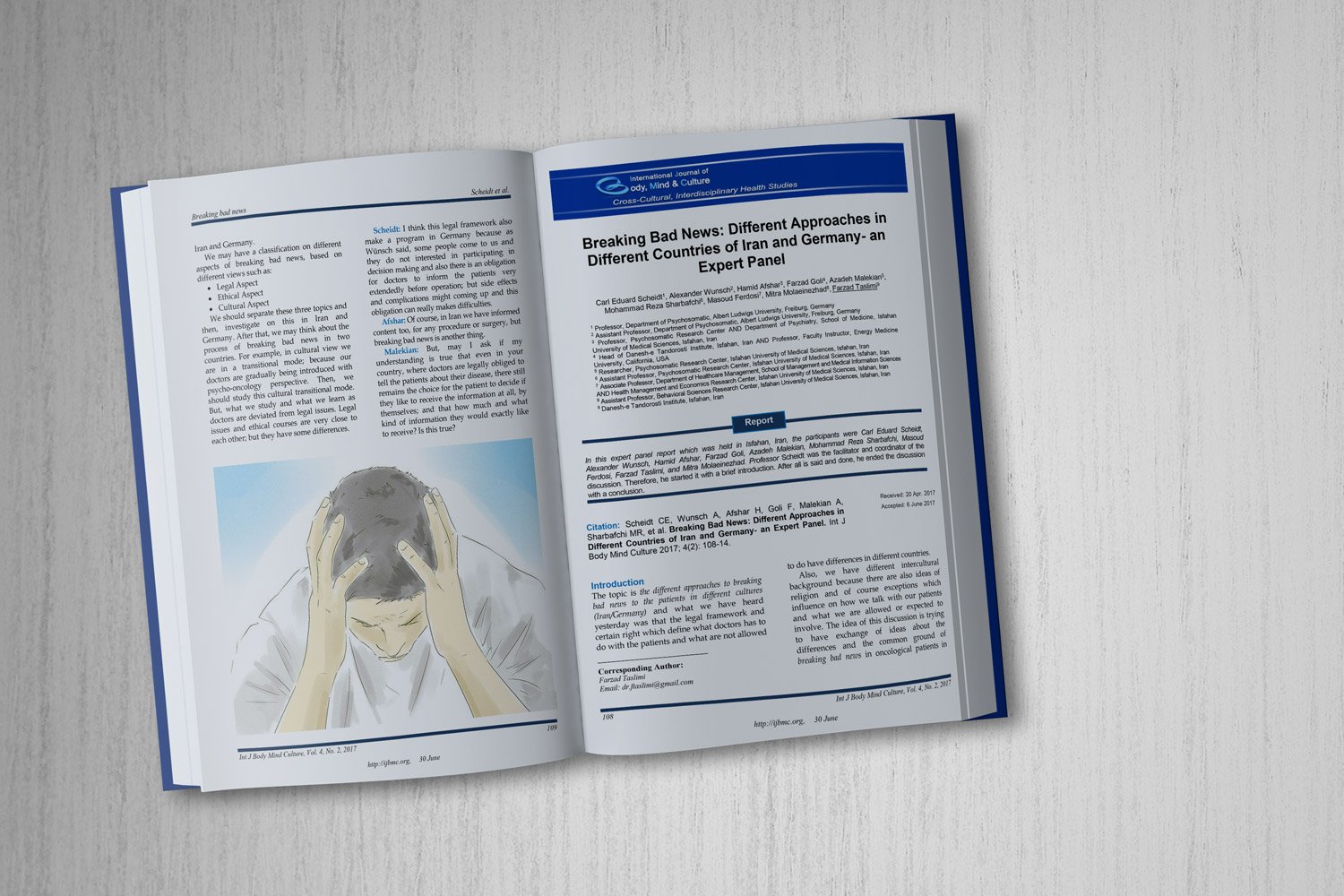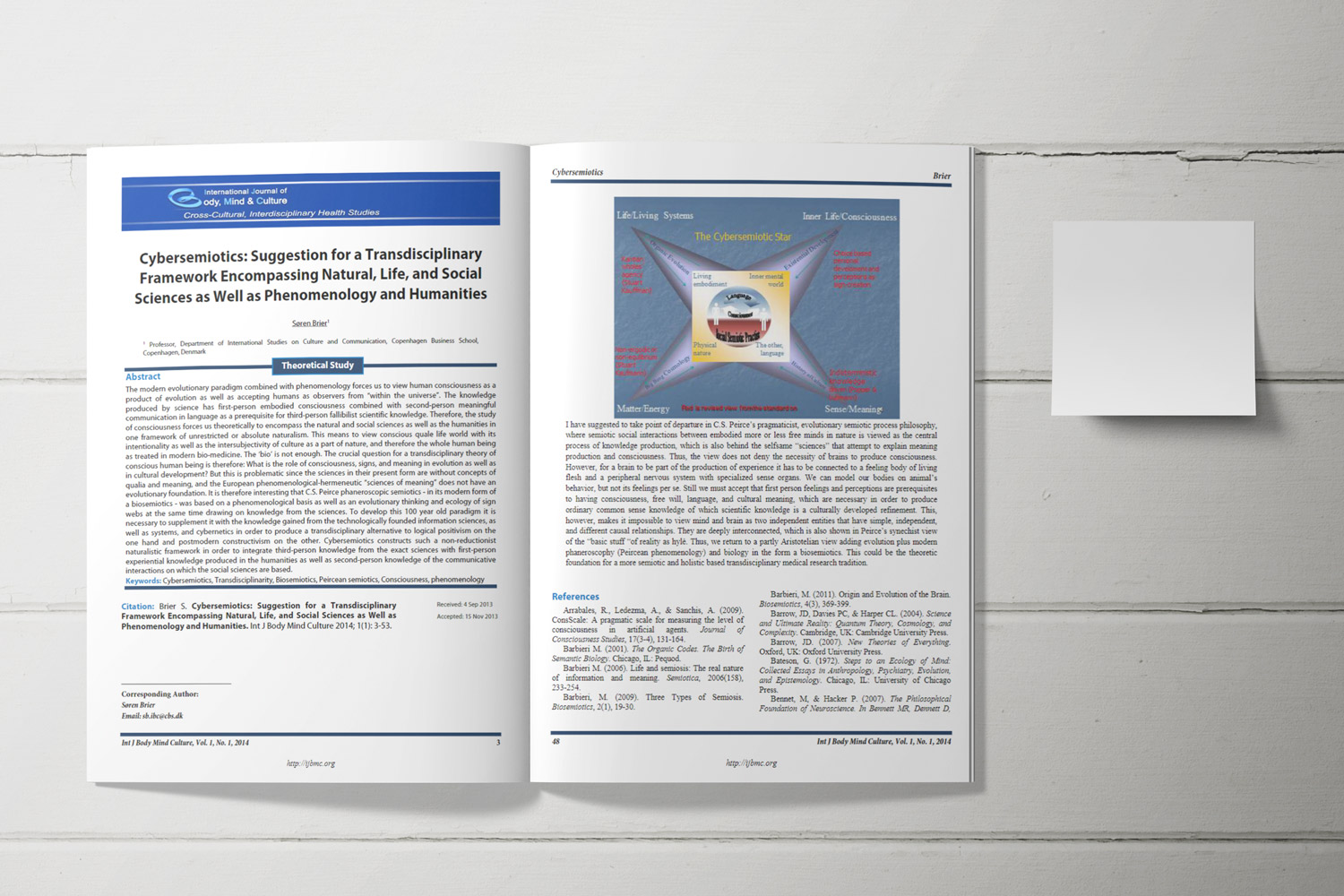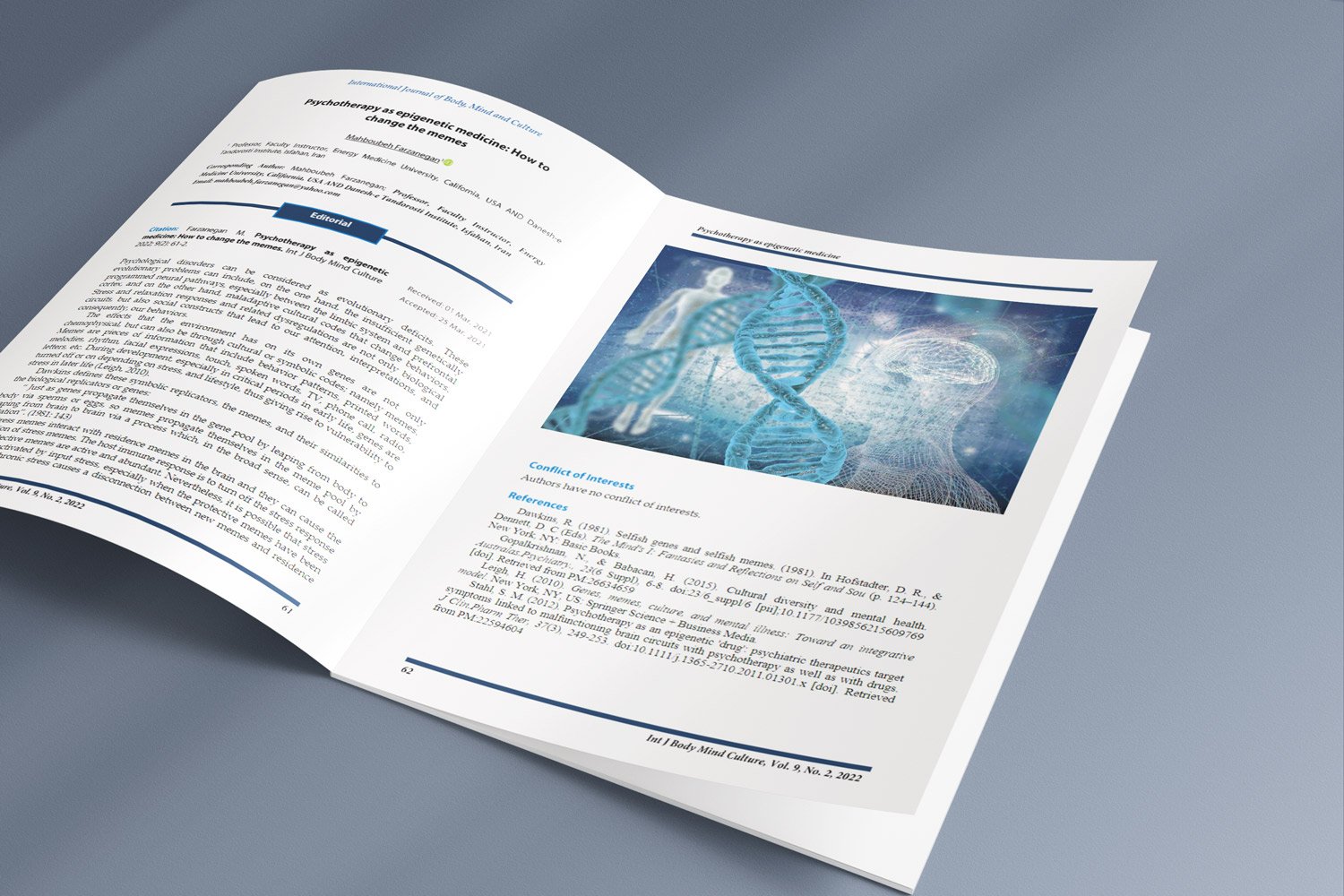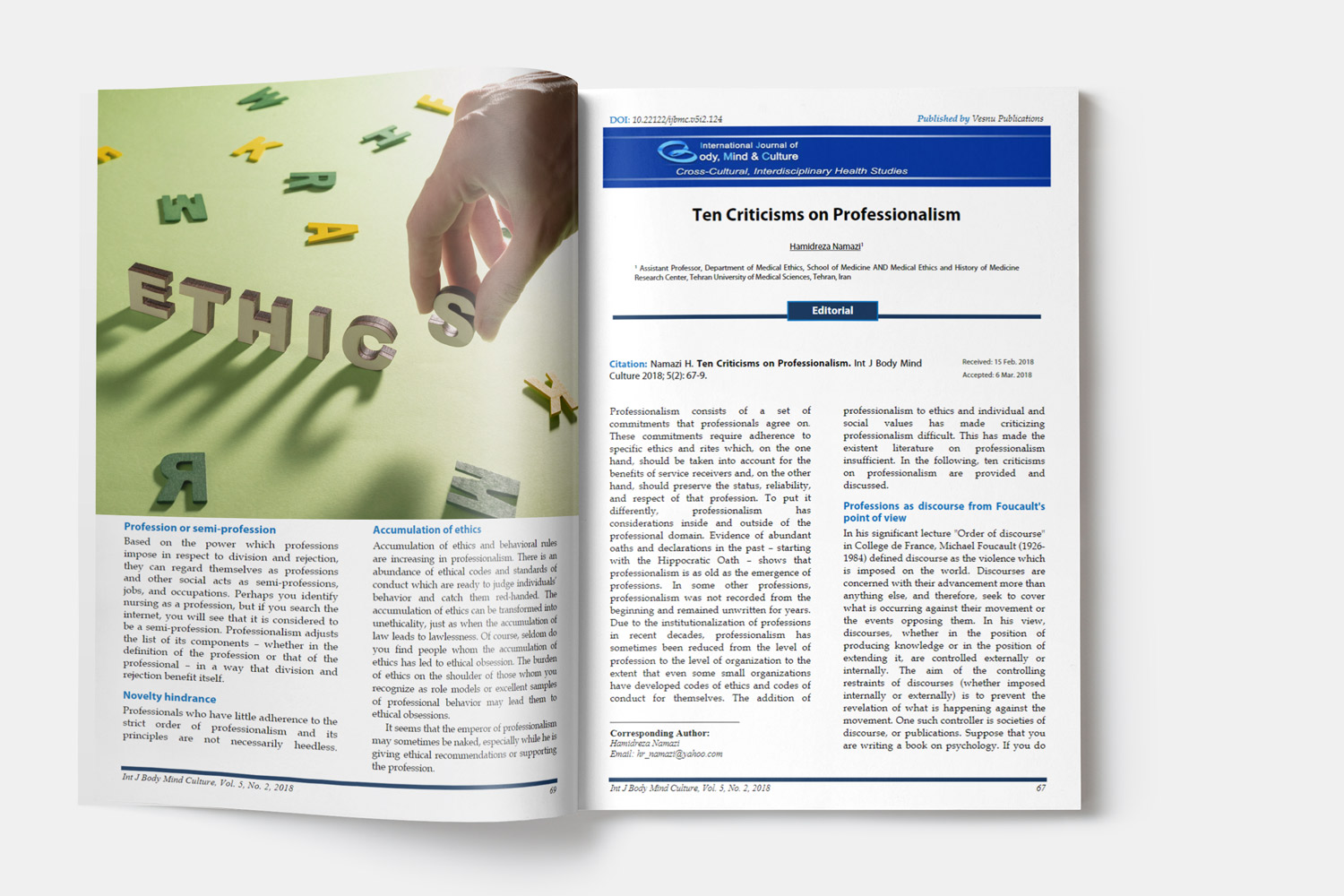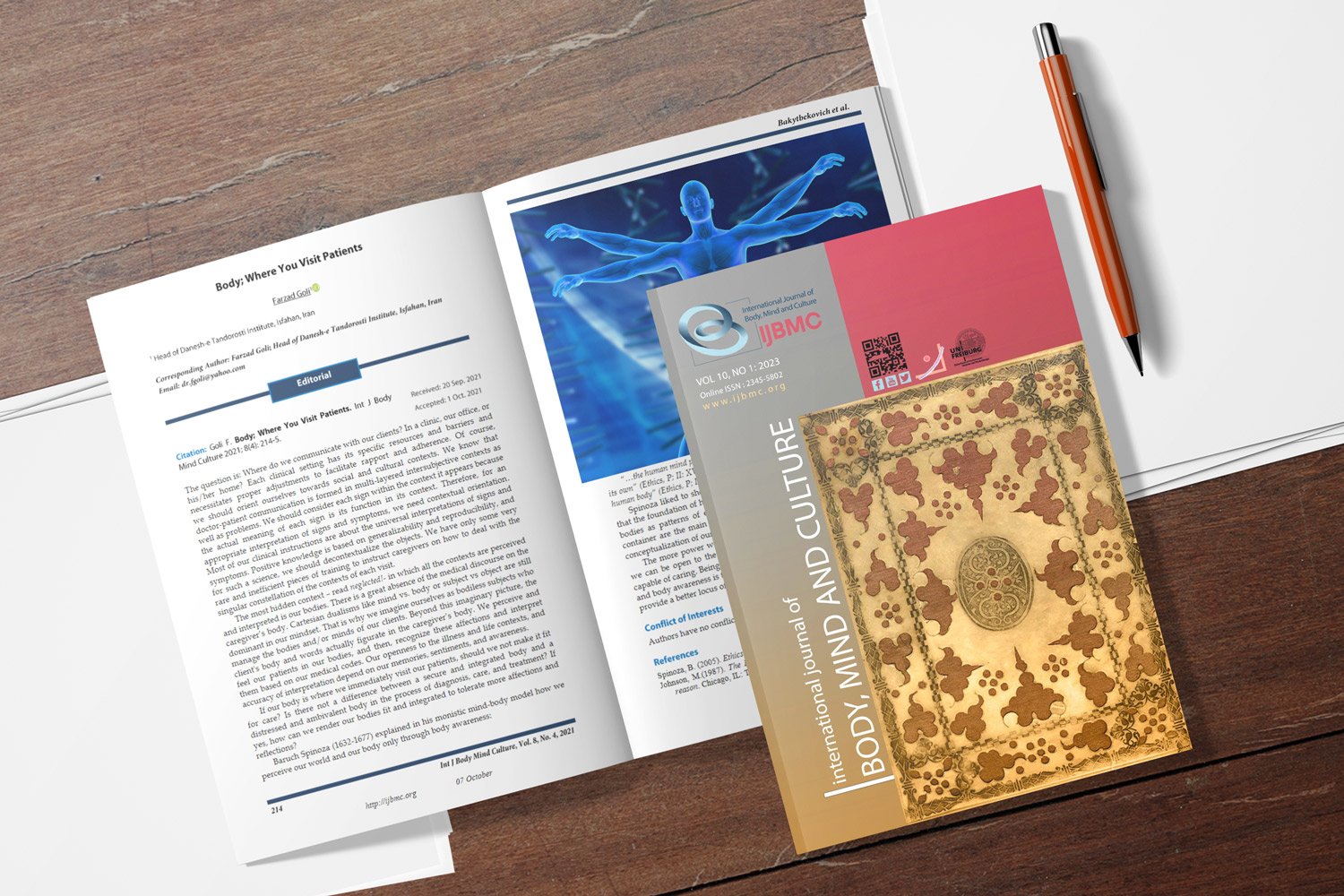Effects of Combined High-Intensity Laser Therapy, Guided Imagery, and Music on Quality of Life and General Health in Patients with Chronic Musculoskeletal Pain: A Randomized Controlled Trial
Downloads
Objective: This study aimed to investigate the effects of combining High-Intensity Laser Therapy (HILT), a non-symbolic physical treatment, with various symbolic/behavioral interventions, including Guided Imagery (GI), rooted in biosemiotics model of healing.
Methods and Materials: This randomized clinical trial included 83 patients with CMSP (aged 18-70 years) who were divided into five treatment groups: Laser Therapy alone (LT), LT + Guided Imagery (GI), LT + GI + Health Education (HE), LT + Music (M), and LT + M + HE. All groups received six sessions of HILT. QoL (SF-12) and general health (GHQ-12) were measured at baseline, post-intervention, and one-month follow-up. Statistical analysis included repeated measures ANOVA.
Findings: Intragroup analyses showed that the PCS improved significantly (p<0.001) only in the combined intervention groups (LT+GI, LT+GI+HE, and LT+MT). GHQ-12 scores (where lower scores indicate better general health) showed significant decreases in the MD component across nearly all groups. The LT+GI group demonstrated statistically superior gains in PMH compared to several other arms (p<0.05). Conversely, the LT+MT group showed the most consistent and significant reduction in the overall GHQ-12 total score during the follow-up phase (p<0.001).
Conclusion: Structured intervention programs substantially enhance quality of life and general health in individuals with CMSP. The findings demonstrate that the integration of symbolic and non-symbolic interventions can be effective for maximizing physical and psychological gains, particularly in physical health status and positive mental health.
Downloads
Arroyo-Fernández, R., Aceituno-Gómez, J., Serrano-Muñoz, D., & Avendaño-Coy, J. (2023). High-intensity laser therapy for musculoskeletal disorders: A systematic review and meta-analysis of randomized clinical trials. Journal of Clinical Medicine, 12(4), 1479. https://doi.org/10.3390/jcm12041479
Astin, J. A., Goddard, T. G., & Forys, K. (2005). Barriers to the integration of mind-body medicine: perceptions of physicians, residents, and medical students. Explore, 1(4), 278-283. https://doi.org/10.1016/j.explore.2005.04.014
Bagheri, M., & Arabi, E. (2018). The mediating role of anger rumination on the relationship between anger and pain intensity in chronic musculoskeletal pain patients. Journal of Research in Psychological Health, 12(3), 34-48. https://dorl.net/dor/20.1001.1.20080166.1397.12.3.5.8
Bathini, M., Raghushaker, C. R., & Mahato, K. K. (2022). The molecular mechanisms of action of photobiomodulation against neurodegenerative diseases: a systematic review. Cellular and Molecular Neurobiology, 42(4), 955-971. https://doi.org/10.1007/s10571-020-01016-9
Bourbonnais, F. F., Perreault, A., & Bouvette, M. (2004). Introduction of a pain and symptom assessment tool in the clinical setting–lessons learned. Journal of Nursing Management, 12(3), 194-200. https://doi.org/10.1046/j.1365-2834.2003.00429.x
Bucci, W. (1997). Psychoanalysis and cognitive science: A multiple code theory. Guilford Press. https://books.google.com/books?id=BKFpGBUAjowC&lpg=PA1&ots=UHUlxTIwdw&dq=Bucci%2C%20W.%20(1997).%20Psychoanalysis%20and%20cognitive%20science%3A%20A%20multiple%20code%20theory.%20Guilford%20Press.&lr&pg=PA1#v=onepage&q=Bucci,%20W.%20(1997).%20Psychoanalysis%20and%20cognitive%20science:%20A%20multiple%20code%20theory.%20Guilford%20Press.&f=false
Bucci, W. (2013). The multiple code theory and the psychoanalytic process: A framework for research. In The Annual of Psychoanalysis, V. 22 (pp. 239-260). Routledge. https://www.taylorfrancis.com/chapters/edit/10.4324/9780203778760-17/multiple-code-theory-psychoanalytic-process-framework-research-wilma-bucci
Chibnall, J. T., & Tait, R. C. (2001). Pain assessment in cognitively impaired and unimpaired older adults: a comparison of four scales. Pain, 92(1-2), 173-186. https://doi.org/10.1016/S0304-3959(00)00485-1
Cinar, E., Saxena, S., & Uygur, F. (2018). Low-level laser therapy in the management of plantar fasciitis: a randomized controlled trial. Lasers in medical science, 33(5), 949-958. https://doi.org/10.1007/s10103-017-2423-3
Conforti, M., & Fachinetti, G. P. (2013). High power laser therapy treatment compared to simple segmental physical rehabilitation in whiplash injuries (1 and 2 grade of the Quebec Task Force classification) involving muscles and ligaments. Muscles, ligaments and tendons journal, 3(2), 106. https://doi.org/10.32098/mltj.02.2013.08
Cuesta-Vargas, A. I., González-Sánchez, M., & Casuso-Holgado, M. J. (2013). Effect on health-related quality of life of a multimodal physiotherapy program in patients with chronic musculoskeletal disorders. Health and Quality of Life Outcomes, 11(1), 19. https://doi.org/10.1186/1477-7525-11-19
Dueñas, M., Ojeda, B., Salazar, A., Fernández-Palacín, F., Micó, J. A., Torres, L. M., & Failde, I. (2016). Use and satisfaction with the Healthcare System of the chronic pain patients in Spain: results from a nationwide study. Current medical research and opinion, 32(11), 1813-1820. https://doi.org/10.1080/03007995.2016.1211519
El-Tallawy, S. N., Nalamasu, R., Salem, G. I., LeQuang, J. A. K., Pergolizzi, J. V., & Christo, P. J. (2021). Management of musculoskeletal pain: an update with emphasis on chronic musculoskeletal pain. Pain and therapy, 10(1), 181-209. https://doi.org/10.1007/s40122-021-00235-2
Elbers, S., Wittink, H., Konings, S., Kaiser, U., Kleijnen, J., Pool, J., Köke, A., & Smeets, R. (2022). Longitudinal outcome evaluations of Interdisciplinary Multimodal Pain Treatment programmes for patients with chronic primary musculoskeletal pain: a systematic review and meta‐analysis. European Journal of Pain, 26(2), 310-335. https://doi.org/10.1002/ejp.1875
Ezzati, K., Laakso, E.-L., Salari, A., Hasannejad, A., Fekrazad, R., & Aris, A. (2020). The beneficial effects of high-intensity laser therapy and co-interventions on musculoskeletal pain management: a systematic review. Journal of lasers in medical sciences, 11(1), 81. https://doi.org/10.15171/jlms.2020.14
Felce, D., & Perry, J. (1995). Quality of life: Its definition and measurement. Research in developmental disabilities, 16(1), 51-74. https://doi.org/10.1016/0891-4222(94)00028-8
Ferrans, C. E. (2010). Advances in measuring quality-of-life outcomes in cancer care. Seminars in Oncology Nursing, https://doi.org/10.1016/j.soncn.2009.11.002
Gatchel, R. J., Peng, Y. B., Peters, M. L., Fuchs, P. N., & Turk, D. C. (2007). The biopsychosocial approach to chronic pain: scientific advances and future directions. Psychological bulletin, 133(4), 581. https://doi.org/10.1037/0033-2909.133.4.581
Goli, F. (2022). Body, meaning, and time: Healing response as a transtemporal and multimodal meaning-making process. In Epigenetics and Anticipation (pp. 79-97). Springer. https://doi.org/10.1007/978-3-031-17678-4_6
Goli, F. (2024). Biosemiotic medicines: Symbolic formulations for placebo enhancements. Journal of Education and Health Promotion, 13(1), 156. https://doi.org/10.4103/jehp.jehp_1888_23
Goli, F., Rafieian, S., & Atarodi, S. (2016). An introduction to the semiotic approach to the placebo responses. In Biosemiotic Medicine: Healing in the World of Meaning (pp. 1-21). Springer. https://doi.org/10.1007/978-3-319-35092-9_1
Greenberg, J., Mace, R. A., Popok, P. J., Kulich, R. J., Patel, K. V., Burns, J. W., Somers, T. J., Keefe, F. J., Schatman, M. E., & Vrancenanu, A.-M. (2020). Psychosocial correlates of objective, performance-based, and patient-reported physical function among patients with heterogeneous chronic pain. Journal of Pain Research, 2255-2265. https://doi.org/10.2147/JPR.S266455
Hadi, M. A., McHugh, G. A., & Closs, S. J. (2019). Impact of chronic pain on patients’ quality of life: a comparative mixed-methods study. Journal of patient experience, 6(2), 133-141. https://doi.org/10.1177/2374373518786013
Hennessy, M., & Hamblin, M. R. (2016). Photobiomodulation and the brain: a new paradigm. Journal of optics, 19(1), 013003. https://doi.org/10.1088/2040-8986/19/1/013003
Kaplun, A., Trosman, S., Reitblat, T., Friedman, A., & Kalichman, L. (2023). The effects of brief guided imagery on patients suffering from chronic back pain: an AB design study. Pain Management Nursing, 24(5), 492-497. https://doi.org/10.1016/j.pmn.2023.06.001
Kenis, V. M., Baindurashvili, A. G., Sapogovskiy, A. V., Melchenko, E. V., Kasev, A. N., & Shpulev, P. S. (2024). Musculoskeletal injuries and pain in children involved in sports: a literature review. Pediatric Traumatology, Orthopaedics and Reconstructive Surgery, 12(2), 271-283. https://doi.org/10.17816/PTORS633296
Kovačević, I., Majerić Kogler, V., Krikšić, V., Ilić, B., Friganović, A., Ozimec Vulinec, Š., Pavić, J., Milošević, M., Kovačević, P., & Petek, D. (2022). Non-medical factors associated with the outcome of treatment of chronic non-malignant pain: a cross-sectional study. International journal of environmental research and public health, 19(5), 2881. https://doi.org/10.3390/ijerph19052881
Laguna, J. M., Puhan, M. A., Artalejo, F. R., De Pauw, R., Wyper, G. M., Devleesschauwer, B., Santos, J. V., & Hincapié, C. A. (2023). Certainty of the global burden of disease 2019 modelled prevalence estimates for musculoskeletal conditions: a meta-epidemiological study. International journal of public health, 68, 1605763. https://doi.org/10.3389/ijph.2023.1605763
Leccese, A., Severo, M., Ventriglio, A., Petrocchi, S., Limone, P., & Petito, A. (2025). Psychological Interventions in Patients with Physical Pain: A Focus on Catastrophizing and Resilience—A Systematic Review. Healthcare, https://doi.org/10.3390/healthcare13060581
Meints, S. M., & Edwards, R. R. (2018). Evaluating psychosocial contributions to chronic pain outcomes. Progress in Neuro-Psychopharmacology and Biological Psychiatry, 87, 168-182. https://doi.org/10.1016/j.pnpbp.2018.01.017
Moulin, D. E., Clark, A. J., Speechley, M., & Morley-Forster, P. K. (2002). Chronic pain in Canada: prevalence, treatment, impact, and the role of opioid analgesia. Pain Research and Management, 7(4), 179-184. https://doi.org/10.1155/2002/323085
Organization, W. H. (2020). Guidelines on the management of chronic pain in children. In Guidelines on the management of chronic pain in children (pp. 56-56). https://pesquisa.bvsalud.org/portal/resource/pt/biblio-1151352
Posadzki, P., Lewandowski, W., Terry, R., Ernst, E., & Stearns, A. (2012). Guided imagery for non-musculoskeletal pain: a systematic review of randomized clinical trials. Journal of Pain and Symptom Management, 44(1), 95-104. https://doi.org/10.1016/j.jpainsymman.2011.07.014
Robinson, J. P., Dansie, E. J., Wilson, H. D., Rapp, S., & Turk, D. C. (2015). Attitudes and beliefs of working and work-disabled people with chronic pain prescribed long-term opioids. Pain medicine, 16(7), 1311-1324. https://doi.org/10.1111/pme.12770
Sani, A. R., & Zin, C. S. (2025). Factors Associated with an Increased Risk of Opioid Misuse Among Patients with Non-Cancer Pain in Malaysian Pain Clinic Settings. Journal of Psychoactive Drugs, 57(4), 444-454. https://doi.org/10.1080/02791072.2024.2387602
Scascighini, L., Toma, V., Dober-Spielmann, S., & Sprott, H. (2008). Multidisciplinary treatment for chronic pain: a systematic review of interventions and outcomes. Rheumatology, 47(5), 670-678. https://doi.org/10.1093/rheumatology/ken021
Schug, S. A. (2020). Treatment of neuropathic pain. Mechanisms of Vascular Disease: A Textbook for Vascular Specialists, 505-524. https://doi.org/10.1007/978-3-030-43683-4_23
Sharma, S., Green, T., Alexander, K. E., & Bonner, A. (2020). Educational or behavioural interventions for symptoms and health‐related quality of life in adults receiving haemodialysis: A systematic review. Journal of Renal Care, 46(4), 233-249. https://doi.org/10.1111/jorc.12329
Shi, Y., & Wu, W. (2023). Multimodal non-invasive non-pharmacological therapies for chronic pain: mechanisms and progress. BMC medicine, 21(1), 372. https://doi.org/10.1186/s12916-023-03076-2
Solano, L. (2010). Some thoughts between body and mind in the light of Wilma Bucci’s multiple code theory. The International Journal of Psychoanalysis, 91(6), 1445-1464. https://doi.org/10.1111/j.1745-8315.2010.00359.x
Song, H. J., Seo, H.-J., Lee, Y., & Kim, S. K. (2018). Effectiveness of high-intensity laser therapy in the treatment of musculoskeletal disorders: A systematic review and meta-analysis of randomized controlled trials. Medicine, 97(51), e13126. https://doi.org/10.1097/MD.0000000000013126
Su, C.-T., Ng, H.-S., Yang, A.-L., & Lin, C.-Y. (2014). Psychometric evaluation of the Short Form 36 Health Survey (SF-36) and the World Health Organization Quality of Life Scale Brief Version (WHOQOL-BREF) for patients with schizophrenia. Psychological assessment, 26(3), 980. https://doi.org/10.1037/a0036764
Tello, N. C., Segura-Ordoñez, A., Banguero Oñate, H. A., & Hurtado Mosquera, J. D. (2025). Physical Exercise and Mental Health in Adolescents: Scoping Review. Revista de investigación e innovación en ciencias de la salud, 7(1). https://doi.org/10.46634/riics.328
Thabet, A. A. E.-M., Elsodany, A. M., Battecha, K. H., Alshehri, M. A., & Refaat, B. (2017). High-intensity laser therapy versus pulsed electromagnetic field in the treatment of primary dysmenorrhea. Journal of Physical Therapy Science, 29(10), 1742-1748. https://doi.org/10.1589/jpts.29.1742
Turk, D. C., & Okifuji, A. (2002). Psychological factors in chronic pain: evolution and revolution. Journal of consulting and clinical psychology, 70(3), 678. https://doi.org/10.1037/0022-006X.70.3.678
Tüzün, E. H. (2007). Quality of life in chronic musculoskeletal pain. Best practice & research clinical rheumatology, 21(3), 567-579. https://doi.org/10.1016/j.berh.2007.03.001
Wscieklica, T., Pellegrini, M. J., Meziat-Filho, N. A., Maldonado, D. C., & Gama, E. F. (2024). Update on chronic musculoskeletal pain: narrative review. BrJP, 7, e20240047. https://doi.org/10.5935/2595-0118.20240047-en
Copyright (c) 2025 International Journal of Body, Mind and Culture

This work is licensed under a Creative Commons Attribution-NonCommercial 4.0 International License.

